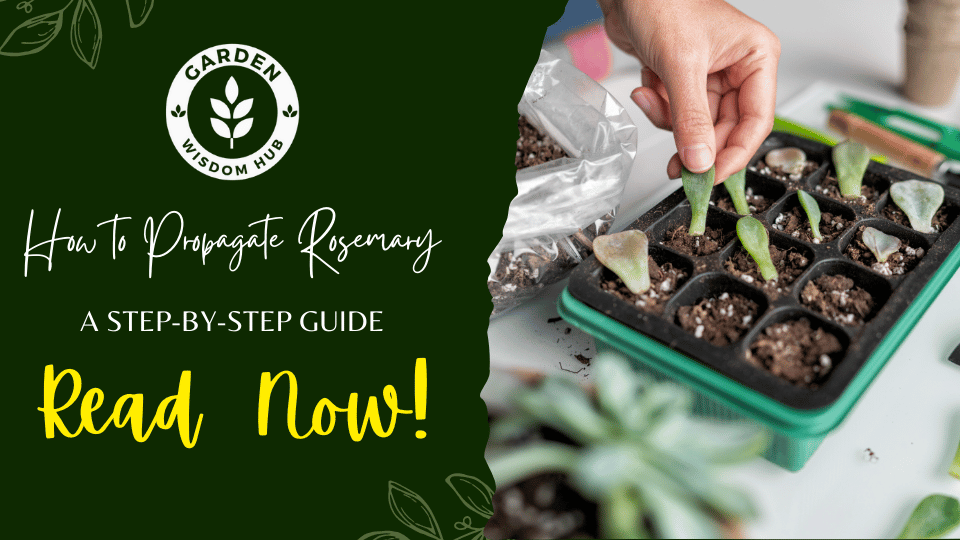How to Propagate Rosemary: Introduction
Rosemary is the queen of herbs, with an aroma to die for and a flair for enhancing any cuisine! Growing rosemary from cuttings is easy and cheap, making it a great method to multiply your green buddies.
This tutorial provides detailed steps to help your rosemary grow like rabbits, whether you plant it in water or soil. We’ll also answer those burning questions and provide some advice.
Can You Root Rosemary Cuttings in Water?
Putting rosemary cuttings in water is simple and effective. You should give it a try. Let me guide you how you can do this by following the below mentioned steps:
Step 1.
Cut a 4-6-inch chunk from the top of a healthy rosemary branch, like cutting a slice of cake at a birthday party. Don’t forget to cut some new growth and a couple pairs of leaves, or you’ll be barking up the wrong tree.
Step 2:
Trim the leaves on the bottom of the cutting, leaving the top two sets standing tall and proud. Like putting the cart before the horse in reverse, this directs plant energy to the roots.
Step 3.
Place the cutting in a glass of water with the cut end deep while the leaves cool to prevent rot.
Step 4.
Change the water every few days to keep it fresh and oxygenated, which helps the roots grow.
Step 5.
Place the glass in a bright area with soft, not-too-hot light! Avoid the sun or you could fry that cutting!
Step 6.
Wait 2-4 weeks for your roots to come together. If the roots are about an inch long, it’s time to plant the cutting! We seem to be in trouble.
When you believe you have everything under control, life surprises you. Trying to find a needle in a haystack, right?
What is the Fastest Way to Propagate Rosemary?
Using soil propagation and rooting hormone is the fastest and most reliable approach to grow rosemary:
- Cut a 4-6-inch piece off the tip of a fresh-as-a-daisy rosemary plant!
- Dip the cut end in rooting hormone powder, gel, or liquid like a fish entering the deep end! This optional step will give those roots a rocket boost in growth!
- Stick that cutting in a draining soil mix like potting soil and perlite or coarse sand to prevent root rot!
- Create a humid refuge by covering the pot with a plastic bag or putting it in a propagation dome like a blanket on a cold night. This keeps roots moist and boosts growth!
- Keep the soil as damp as a fish’s backside and place the pot in a sunny, warm position that’s not blasted by direct sunshine like a deer in headlights. In 1.5 months, those roots should grow like spring daisies.
Can I Grow Rosemary from a Cutting?
Absolutely! Snipping rosemary and watching it grow is simple! It’s like trimming the plant and letting it grow a family tree.
Cuttings are like gardening’s rapid rabbits, growing new plants quickly while seeds take their sweet time. Cuttings retain all the greatest qualities of the original plant! You can immerse a rosemary snip in water or plant it in the soil—whatever you choose.
Does Rosemary Need Full Sun?
Rosemary soaks up the sun like a beach bum! For its best performance, it needs 6-8 hours of sunlight daily. When growing rosemary indoors, place it near a south-facing window so it may soak up the sun like a cat on a warm windowsill.
If the light hides, your plant may stretch its legs too far and look like a lanky teenager! Choose a light spot to help your green friend thrive.
Steps to Spread Rosemary Love: Discuss 5 steps
Step 1:
- Choose a healthy parent plant. Start by choosing a vibrant rosemary shrub to cut from! Some pearls of wisdom:
- Pick a plant that’s been around for at least 2-3 years; it’s got deep roots, giving you a leg up on successful propagation.
- Look for fresh, bendy growth instead of old, gnarly branches, because young sprouts take root like a duck to water.
- Avoid snipping from a weathered or hot plant, as this could lower your success rate.
Step 2:
- Trim Rosemary. A successful garden requires proper cuts. Cut a 4-6-inch chunk from a healthy stem like cutting fat from a tasty steak.
- Use fancy scissors or pruning shears to cut through like butter! Cut off the bottom leaves on the cutting, letting the top two sets shine.
- This prevents rot and encourages the plant to establish roots! Take some snips to increase your chances of winning with propagation. Taking a few cuttings from the same plant is easy!
Step 3:
- Prepare Potting Soil. Don’t rush—get the correct potting mix for soil propagation! To prevent your plants from drowning, choose potting soil with perlite or gritty sand that drains well.
- This prevents damp soil from hiding rot among roots. Like wetting your whistle before a heavy meal, moisten the earth before planting that cutting! Let’s keep the soil moist like a sponge without drowning it.
Step 4:
- Soak that rosemary stem in rooting hormone. Rooting hormone gives plants a magical boost in the root race, especially semi-hardwood cuttings like rosemary that are eager to grow.
- Dunk the cut end of the rosemary stem in rooting hormone powder, gel, or liquid and let it soak up the magic! It may not be the cherry on top, but adding a bit of salt to a recipe could enhance your success rates.
- Avoid overdoing it by shaking off any additional hormones, which could hinder the cutting.
Step 5:
- Plant your rosemary cutting! Time to get that cutting in the ground, guys!
- Use a pencil or finger to poke a tiny hole in the potting soil, like a balloon pin without the blast! Place the cutting in the hole and give the dirt a gentle tap to secure it!
- To warm the soil surrounding the cutting, sprinkle lightly but don’t drown it. Too much water can make your cutting mushy before it roots.
- Put a translucent plastic bag or dome on that pot to create a mini-greenhouse, increasing humidity and helping those roots grow like weeds.
- Put that pot in a bright spot where it can get indirect sunlight, like a pleasant corner beside a window that maximises natural light.
Alternative Methods and Tips: How to Propagate Rosemary
Let us discuss other Tips and Tricks Growing Rosemary from Water Cuttings.
How to Grow Rosemary from Cuttings in Water: A Snip and Sip Adventure
Easy water propagation is great for beginners in gardening! Follow the flow like we did with water propagation.
Don’t forget to shake that water occasionally and let it soak up some soft sunshine—no need to plunge it in!
Propagating Rosemary with Honey
Honey can act as a rooting hormone, like a bee saving the day! Try soaking the cut end in honey before planting it. Honey helps prevent problems and encourages roots to grow like weeds.
How to Propagate Rosemary in Soil
The old-fashioned approach of planting it in the earth works best! Use soil that drains like a sieve and keep the cutting area damp like a rain forest. Keep the soil as damp as a fish’s backside until the roots form, then reduce watering as the plant settles.
Frequently Asked Questions: How to Propagate Rosemary.
Is it possible to grow rosemary from snips?
Bet your boots! Like garden weeds, rosemary clippings can grow! Clippings from healthy, ripe plants should be trimmed.
Is Rosemary Easy to Grow from Cuttings?
For sure! Even novice gardeners can propagate rosemary easily.
Can I Grow Rosemary Indoors?
Yes! If it gets enough sunlight, rosemary can thrive indoors beside a south-facing window or under a grow lamp like a beachgoer.
How Long Does Rosemary Get Twisted Roots?
You should expect rosemary cuttings to sprout in 4–6 weeks, give or take a few days depending on your cooking conditions.
Butter my biscuit! Our progress appears to have stalled. When you believe you have everything under control, life surprises you. Every cloud has a silver lining, right? Let’s ride with it.
Conclusion: How to Propagate Rosemary
Following these methods and recommendations will help you grow rosemary like a pro and enjoy homegrown herbs in your yard and kitchen. No problem, and soon you’ll be cooking like a pro with your green thumb! May your gardening efforts flourish. Do not forget to check out our other articles on the following topics:
- When to Harvest Butternut Squash
- Growing Lettuce in Containers
- How to Harvest Lettuce Seeds
- Growing Radishes in a Container
- Rosemary Companion Plants
- How Often to Water Rosemary
- Companion Plants for Cauliflower
James Porter
Welcome to our haven of gardening and plant care, where outdoor and indoor planting enthusiasts come together! At Gardening Wisdom Hub, we aim to provide you with the most authentic information on anything related to gardening, plant care, seasonal planting etc.
The author of our website is James Porter, an experienced industry veteran. He has a deep interest in everything green. James’s enthusiasm for exploring plants’ features and learning new gardening methods began at a young age. Gradually, his passion increased with time, leading him to become a highly esteemed professional. His extensive knowledge makes him a priceless resource for inexperienced and seasoned gardeners.

